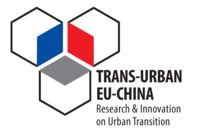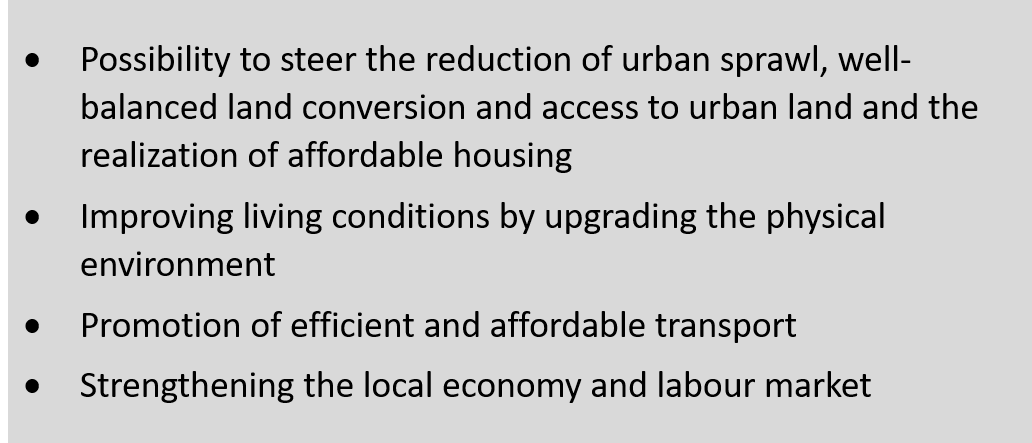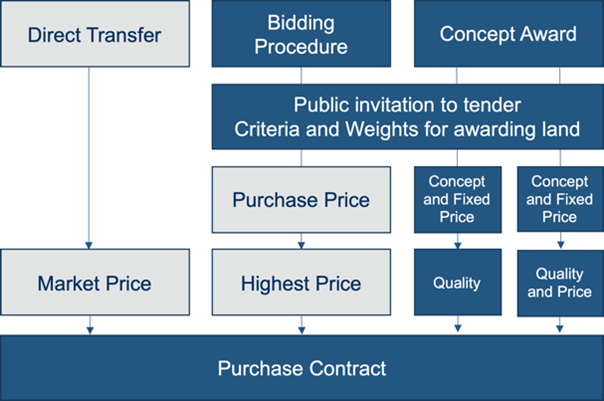
TRANS-URBAN-EU-CHINA
Transition towards urban sustainability through socially integrative cities in the EU and in China
Allocation of municipal plots with application procedure (concept award)
1. Purpose(s)
The idea of allocation of municipal plots with application procedures (concept award) is not to award the bid to the highest offer but to focus the selection on the best concept. Predefined criteria of the municipality channel the ideas but leave scope for innovative projects. The bidder is bonded to the concept, so the municipality secures its interests.
In general, the transaction of a municipal property can be carried out according to three different procedures: Direct transaction, bidding procedure or concept award. The city decides on one of the three procedures. The concept award is particularly suitable for municipalities that want to sell their plots, but at the same time want to base this sale on the compliance with previously clearly defined development goals (Architekten- und Stadtplanerkammer Hessen K.d.ö.R. und Hessischer Städtetag e.V. 2017).
In the case of direct transfer, the land changes ownership at the market price. The bidding procedure and the concept award are initially similar. The city initiates a public invitation to tender for the area and defines usage and design criteria and it's their weighting for the sale of the area. In the bidding procedure, only the purchase price offered is relevant. The land is sold to the bidder with the highest price, under the prerequisite that the bidder will plan the area according to the city’s criteria (Architekten- und Stadtplanerkammer Hessen K.d.ö.R. und Hessischer Städtetag e.V. 2017; Hessisches Ministerium für Umwelt, Klimaschutz, Landwirtschaft und Verbraucherschutz 2017).
In addition to the price to be paid for the acquisition, the buyers must submit a concept of the planned project, which is binding for both parties if the offer is accepted (regulated in the sales contract).
A concept award consists of at least two stages: the selection procedure and then the quality assurance phase, which is often accompanied by an appendix or an option, which clarifies the conceptual, legal and financial framework. This phase is not only important for quality assurance, but also for clarifying important elements of project development (e.g. financing); it ends with the acquisition of land. Some procedures also introduce a participant application phase before the actual selection or a simplified first stage of the procedure to reduce the number of projects to be compared (Temel 2019). Figure 1 summarises the general procedure of a concept award.
In practice, very different criteria are used to select these concept awards and almost always it is about the concept of use. In detail, the concept of use is about, which uses are located on the ground floor and above, what residential typologies are offered, how businesses are involved and which social mixes are created. Often architecture and urban development quality are separate criteria. It frequently is a question of social concepts, how to improve social standards for example, the setting of rent limits (affordable housing), the proportion of subsidised housing construction or the implementation of other social uses. Finally, questions of feasibility, urban development aspects, ecological aspects, open-space planning aspects, energy aspects and financing can be important factors (von Bodelschwingh & Gilewski 2016).
Key Words: Land development, steering measures, transaction, municipal land, purchase, social criteria, quality of land development, concept tendering
2. Relevance and Impact
Above all, the participation of different stakeholders has been focused on in urban development in recent years. Concept awards promote the cooperation and participation of different stakeholders. With the use of criteria in the concept award, the municipality can define aspects of socially integrative cities as a framework for a project proposal. The individual design of the criteria is up to the bidders. The instrument offers the bidders some room for manoeuvre in the design. Nevertheless, it can be ensured that they take into account interests of the municipality to promote socially integrative cities.
The instrument is widely used in China as well as in European countries. In discussions within the project it became clear that this is not a new approach, but an instrument that has been used for a long time and is considered as a good practice in urban development.
Issues of social inclusion can be addressed in the context of concept awards. The municipality can define the framework based on the previously identified needs and objectives of urban development. The best concept award can be selected based on the submitted several concepts.
To achieve urban development and housing policy objectives, cities, as organisers of conceptual procedures, use a variety of different criteria that enables them to compare the quality of the projects submitted. Some of these criteria are evaluated based on complex point matrices, in other cases, the evaluation is also carried out holistically in the form of unweighted criteria lists. In addition to securing its goals, the municipality is provided with innovative ideas from which it can choose the best ones for its development.
Models for a conceptual award can contribute towards the reduction of urban sprawl, balance land conversion and access to urban land. Also, community specifications can contribute to improving the environmental and living conditions. Infrastructural aspects such as the promotion of efficient and affordable transport can also be defined. The specifications of the municipality can contribute to strengthen the local economy and the labour market as well as to the fostering of (technical and social) innovation in cities and districts. They can also support appropriate institutional and urban funding mechanisms. Box 1 summarises the main points of promoting socially integrative cities.
3. Strenghts
Concept awards are very useful in fostering urban development quality (diversity, mix of uses, high-quality ground-floor use, architecture, sustainability, quality of open spaces, participation, cooperatively developed infrastructure, social mix, promotion of neighbourhood). They are helpful particularly supporting affordable housing. All concerns can be promoted with well-implemented concept procedures. In this aspect, concept awards have excellent development prospects.
Concept awards are well suited to integrate stakeholder participation formats and benefit from them for the procedure itself and the forthcoming projects. In some cases, participation is also directly linked to the conceptual procedure, for example through preparatory workshops, in which work on the framework conditions and contents for the call for proposals is done; through information events, which also serve the finding groups and partners; through civic representatives in the decision-making body or quality assurance; through exhibitions of the submitted projects and evaluation by the interested public before the decision is made; and through the discussion of the projects with the public after the decision has been made. This obtains a basis for further processing (Temel 2019).
Concept awards also offer urban planning the essential advantage of a target-oriented control of urban development. They create diversity and make enable the municipality to use the creativity and innovative power of different stakeholders (Stadtwerkstatt Berlin 2019). This is achieved by awarding public plots of land according to the quality of the submitted concept, which is evaluated according to award targets from the areas of housing, urban development and environmental policy (Peters, 2020). At the same time, the criteria and objectives can be geared towards making cooperatives and building groups permanent partners in urban development. The coordination between the various stakeholders automatically develops into a criterion in urban development and offers the possibility to apply the objectives and criteria for the concept award to future planning and stakeholders (Temel 2019).
Figure 2 shows the opportunities of selling municipal land. In the case of concept awards, the price of public land may only play a subordinate role (Hessisches Ministerium für Umwelt, Klimaschutz, Landwirtschaft und Verbraucherschutz 2017). Consequently, reorganising the public budget by means of land sales is not a primary objective. In return, however, lower land prices make it possible to set high-quality standards and prevent gentrification. This is often accompanied by an activation of the population, which in return requires participation in the planning process (Stadtwerkstatt Berlin 2019). Advice and coordination centres for the population, but also developers, should therefore, be set up in order to cope with the increased placement effort.
4. Weaknesses
Concept awards are very supervision-intensive processes that cannot always be implemented under high time pressure. The municipality has to sell its land and has no long-term influence.
Particularly in the case of cities for which concept awards are new, interest in participation must be examined and fostered by the municipality before the conducting of the actual procedure. In cities where concept awards are a relatively new model, the framework conditions can vary greatly between individual procedures. This can lead to unequal treatment and makes it difficult to objectively examine and compare individual procedures. Conflicts between areas of the city administration that are carried out in connection with such a procedure can lead to delays, impair the results and place demands on participants that are far removed from practice, thus massively impairing success (Temel 2019).
Concept awards are partly embedded in political programs, from housing construction concepts and building community programs to concepts relating to land policy and urban planning. In some cases, the central political body of the respective city also determines how concept tendering models are to be carried out and which criteria and specifications are to be applied. Some cities have defined that concept awards must be carried out for all urban housing areas above a certain size, or that building associations or other target groups must be offered to purchase a certain percentage of housing areas. These requirements are potentially too narrowly defined and do not leave enough room for practical implementation (Temel 2019).
A critical aspect of concept awards is the question of how the qualities promised in the procedure can be safeguarded until implementation and in the long term in use. This requires either a correspondingly consistent, ongoing monitoring or an examination at certain milestones, such as when the building application is submitted (Temel, 2019). Another difficult aspect is that, at least, in the first phase of project development, cooperation between the individual projects in an area is hardly possible because they compete for land (Temel 2019).
5. Good practice examples
Rieselfeld, Freiburg (map)
In the 1990s, reacting to the growing population, following the city commitment to sustainable development, the Freiburg City Council decided to create the urban extension of Rieselfeld. The project was developed on 70 hectares of a publically owned former sewage farm, located in the southwestern part of Freiburg (Schuetze, 2019). After extensive ground surveys were done and necessary steps such as soil removal were taken, the area fulfilled the conditions for residential construction (City of Freiburg, 2007). The land use was converted to building land according to the German Building Code. The design code of Freiburg was discussed among several actors in working groups including more than 80 citizens. In the Rieselfeld masterplan , land blocks were divided into small lots parcelled out in between five to 10 investors (Siegl 2009).
The planning department made a program and discussed it with the city council. A concept award was launched (Architekten-und Stadtplanerkammer Hessen K.d.ö.R. and Hessischer Städtetag e.V. 2017). Around 40 groups of co-building, co-housing and self-builders were created (Hamiduddin and Gallent 2016, Mahzouni 2017). They made an urban contract (following strict design and ecological guidelines and a water scheme) and presented their drafts to the city to request a site [1]. Based on the results, a business plan was drawn up and a loan from a bank was obtained to start the project and finally, all plots were sold. They paid for all necessary physical and social infrastructure. The formation of co-builder groups created a specific structure and identity within the community and made it easy to keep in touch with future residents. The final result of involving different developers was a quite diverse architecture (URBED, 2008), including densely built blocks, ribbon development, townhouses, duplex houses, terraced houses and the housing arc (Siegl 2009).
The project was carried out by the city administration in cooperation with a municipal provider from Stuttgart (Kommunalentwicklung LEG). They appointed a joint management team (the Rieselfeld Project Group) in the form of a development management agency, which helped to integrate economic knowledge and financial resources of the private developers into those of the city [2]. The team acted beyond the regular administrative hierarchy and was supported by experts from different city administration units such as planning, real estate and housing (Mahzouni 2018, Siegl 2009).
[1] http://ucdesustainability.blogspot.com/2009/08/comparison-of-rieselfeld-and-vauban.html (retrieved April 3 2019)
[2] http://www.eltis.org/discover/case-studies/rieselfeld-tramway-freiburg-germany (retrieved April 3 2019)
6. References
CITY OF FREIBURG. 2007. The new district of Freiburg-Rieselfeld. A case study of succesful, sustainable urban development. In: RIESELFELD, P. (ed.). City of Freiburg.
FASTENRATH, S. & PRELLER, B. 2018. Freiburg: The Emblematic Green City. In: AFFOLDERBACH, J. & SCHULZ, C. (eds.) Green Building Transitions. Regional Trajectories of Innovation in Europe, Canada and Australia. Springer.
HAMIDUDDIN, I. & GALLENT, N. 2016. Self-build communities: the rationale and experiences of group-build (Baugruppen) housing development in Germany. Housing Studies, 31, 365-383.
ARICHITEKTEN- UND STADTPLANERKAMMER HESSEN K.D.Ö.D AND HESSISCHER STÄDTETAG E.V. 2017. Orientierungshilfe zur Vergabe öffentlicher Grundstücke nach Konzeptqualität.
HESSISCHES MINISTERIUM FÜR UMWELT, KLIMASCHUTZ, LANDWIRTSCHAFT UND VERBRAUCHERSCHUTZ. 2017. Grundstücksvergabe nach der Qualität von Konzepten. Verfahren und Praxisbeispiele.
MAHZOUNI, A. Living and Sustainability: An Environmental Critique of Design and Building Practices, Locally and Globally. AMPS Proceedings 2017 London South Bank University, London. 394-402.
MAHZOUNI, A. 2018. Urban brownfield redevelopment and energy transition pathways: A review of planning policies and practices in Freiburg. Journal of Claener Production, 195, 1476-1486.
ARCHITEKTEN-UND STADTPLANERKAMMER HESSEN K.D.Ö.R. & E.V., H. S. (2017.). Orientierungshilfe zur Vergabe öffentlicher Grundstücke nach Konzeptqualität.
Peters G. (2020) Konzeptvergabe – Baustein einer sozial gerechten Stadtentwicklung. In: Etezadzadeh C. (eds) Smart City – Made in Germany. Springer Vieweg, Wiesbaden. TEMEL, R. 2019: Baukultur für das Quartier. Prozesskultur durch Konzeptvergabe. Endbericht.
SCHUETZE, T. 2019. Vauban and Rieselfeld, Freiburg, Germany: Innovation in the implementation process. In: DARCHEN, S. & SEARLE, G. (eds.) Global Planning Innovations for Urban Sustainability. Routledge.
SIEGL, K. 2009. The new district of Freiburg-Rieselfeld: a case study of successful, sustainable urban development. In: SIEGL, K. (ed.). Freiburg: Stadt Freiburg. doi.org/10.1007/978-3-658-27232-6_44
STADTWERKSTADT BERLIN. 2019. Dokumentation. Werkstatt Konzeptverfahren.
TEMEL, R. 2019: Baukultur für das Quartier. Prozesskultur durch Konzeptvergabe. Endbericht.
TRANS-URBAN-EU-CHINA. 2020. Land management instruments for socially integrative urban expansion and urban renewal in China and Europe. D 3.3 Report
URBED. 2008. Eco-towns:Learning from International Experience. London: PRP, URBED, Design for Homes.
VON BODELSCHWINGH, A. & GILEWSKI, A. 2016. Kommunale Handlungskonzepte und Ansätze zur Feinsteuerung. In: von Einem E. (eds) Wohnen. Stadtforschung aktuell. Springer VS, Wiesbaden.
7. Author(s) of the article
Julia Süring, Paulina Schiappacasse


